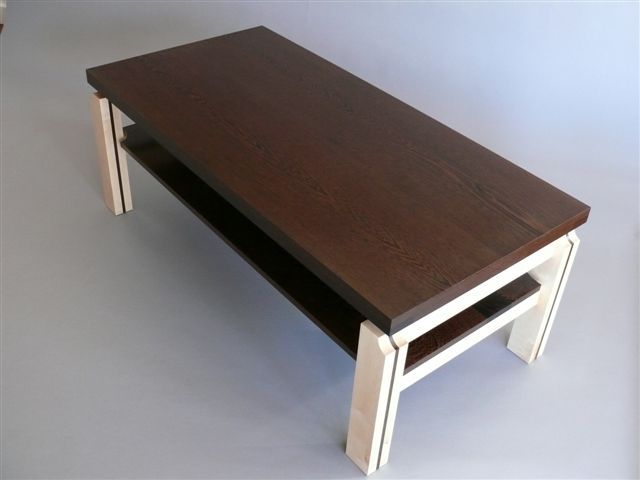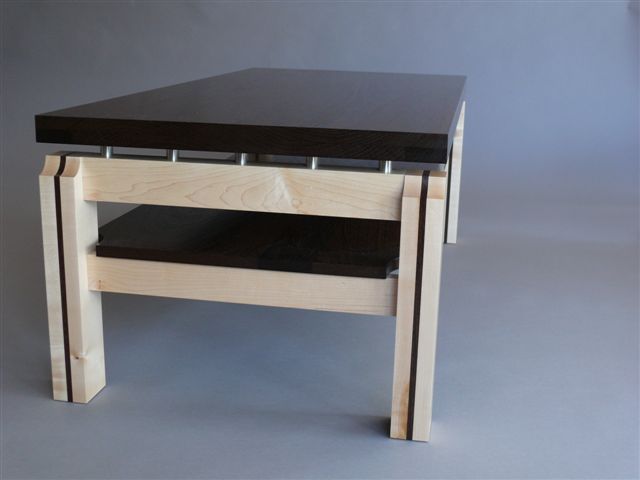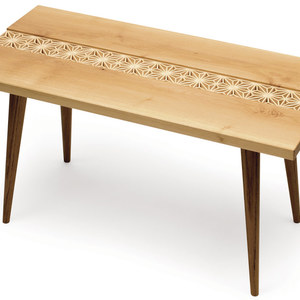Paddy and John’s coffee table

This coffee table in wenge, rock maple and stainless steel was made for my sister Paddy and her husband John. This was the first time time I had seriously used wenge in a project and it will probably be the last. I now know why it has been referred to as ‘organic steel’! To allow for wood movement, the stainless steel pins supporting the top are attached to a separate ‘plate’ that in turn is attached to the top by buttons and screws in slots. With an ‘apron’ of wenge 20 mm thick glued underneath the solid top, also 20 mm thick, the top has the appearance of being 40 mm thick.




















Comments
I like the design, the materials, and the execution. The combination of materials, forms, and dark/light color contrasts is very intriguing. Well done!
P.S. If steel could splinter it would be more like wenge :-)
Having amassed a pile of wenge for a project, I'd be grateful for more specific comments about the problems you encountered working with wenge. I know that it tends to splinter, but what other problems did you encounter? Was it mostly that it is very hard? Also, what finish did you use for the table? Thanks.
Nice work, by the way!
Most of the books I consulted almost unanimously referred to wenge as having a 'moderate' blunting effect on cutting edges. All I can say is that those writers have a rather curious understanding of the meaning of the word 'moderate'. I would describe its blunting effect as 'brutal'. I only had a small amount of paring to do on the wenge, but this left the edges on some Japanese chisels in a rather sorry state. However, some HSS chisels (Harold and Saxon, an Australian brand) stood up rather better. But it was on the jointer where wenge showed how tough it was. Starting with fresh blades, it wasn't all that long before the blades were just bouncing off the wood rather than cutting it! Sawing the wenge also requires special care. A knife line is no guarantee against tear out underneath when performing cross cuts, and it is necessary to place tape over the knife line as added insurance.
You have also referred to the problem of splinters. I would recommend wearing gloves when handling wenge in its undressed state.
Sanding also presents difficulties. Apart from the potential health risks from the dust, I found that the tan bands are rather softer in comparison with the black bands, with the consequence that they wear away more quickly causing undulations between the bands, particularly where the alternating bands are wide. Presumably this is the result of differences in seasonal growth. I would recommend hand sanding rather than, say, an orbital sander.
Some of the numerous and prominent pores of wenge will also break out at the arris, so it is impossible to achieve a consistently sharp arris. And if you are sanding wenge in conjunction with a light timber such as maple there is the problem of ensuring that the dark sanding dust of the wenge doesn't stain the latter.
Frankly wenge has absolutely nothing to commend it save that it looks so darn good!
The finish is a workshop finish which uses a 50/50 mix of 2 Australian products - Feast and Watson's Fine Buffing Oil and Satinproof, a polyurethane. I suspect that there is not all that much tung oil in the Buffing Oil, so for all intents and purposes this is a wiping varnish. I sanded to 1200, denibbing twice at 400 and 1200. The finish was applied in sections with a pad (cotton wool wraped in old bed linen) with the excess taken off immediately with fresh pads. I gave it 4-5 coats, allowing about 24 hours between coats. All surfaces were then waxed with Liberon's Black Bison Paste Wax using 0000 steel wool. I used their 'Dark Oak' for the wenge. This was important as the pores were left unfilled, and it was inevitable that some of the wax would be left in the pores. As the wax was applied over the varish rather than bare wood, the wax was applied in stages and then buffed off almost immediately.
Log in or create an account to post a comment.
Sign up Log in